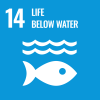
Genetic analysis proves white seabass replenishment success
In a four-year collaborative study between HSWRI and the South Carolina Department of Natural Resources (SCDNR), genotypes were made for 500 seabass brood fish dating back to 1996, when the Carlsbad hatchery first started operation. SCDNR was able to use a genetic marker to supplement coded wire tagging (CWT) data. Using the genetic marker, we found the hatchery contribution rate in the wild was substantially higher than CWT return rates. HSWRI is continuing this research with SCDNR into the future using private contributions to confirm the success of our replenishment program through genetic analysis.
